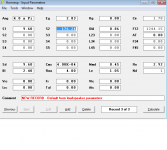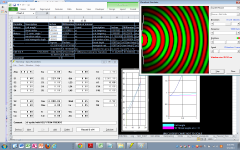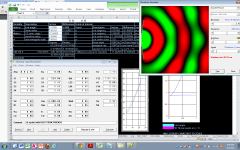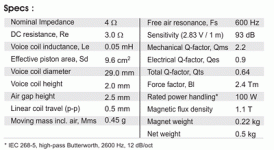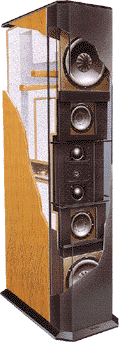updates of driver parameters and Hornresp
Here are the updated (measured specs) for the SB29RDC. Ive also attached what I think would be used to model the OS given this info....
Now what do I look for when determining the current profile (IE how can I tell what it should look like in wave simulator?)
TS Parameters file
Room EQ V5.01
Dated: Aug 14, 2013 7:08:24 PM
From measurement Aug 14 18:58:23
Zmin 3.38 ohm
fmin 2164 Hz
f3 20000 Hz
Le(f3) 0.011 mH
Motional impedance parameters
RES 17.20 ohm
LCES 0.595 mH
CMES 91.6 uF
RAMS 17204.495 mohm
Blocked impedance parameters
RDC 2.20 ohm
dR 0.72 ohm
Re 2.92 ohm
Leb 1.5 uH
Le 1.052 mH
Rss 143.1 ohm
Ke 0.0055 S-H
Thiele-Small parameters
fs 668.8 Hz
Qms 2.869
Qes 1.123
Qts 0.807
Fts 828.5
Here are the updated (measured specs) for the SB29RDC. Ive also attached what I think would be used to model the OS given this info....
Now what do I look for when determining the current profile (IE how can I tell what it should look like in wave simulator?)
TS Parameters file
Room EQ V5.01
Dated: Aug 14, 2013 7:08:24 PM
From measurement Aug 14 18:58:23
Zmin 3.38 ohm
fmin 2164 Hz
f3 20000 Hz
Le(f3) 0.011 mH
Motional impedance parameters
RES 17.20 ohm
LCES 0.595 mH
CMES 91.6 uF
RAMS 17204.495 mohm
Blocked impedance parameters
RDC 2.20 ohm
dR 0.72 ohm
Re 2.92 ohm
Leb 1.5 uH
Le 1.052 mH
Rss 143.1 ohm
Ke 0.0055 S-H
Thiele-Small parameters
fs 668.8 Hz
Qms 2.869
Qes 1.123
Qts 0.807
Fts 828.5
Attachments
Now - is this good, bad, or just plain ugly and why???
Hi Michael,
Just to clarify:
S1 = 9.60 sq cm equates to a throat radius of 17.48 mm. This is different to the 21.93 mm value shown in the spreadsheet.
Which is correct?
Kind regards,
David
good question:
what is correct is actually 21.94 mm (cannot see it on the spreadsheet - but since throat angle effectively "moves" that point along x axis (that's that greenish vertical line real close to 0).
21.94 mm was obtained via a measured diameter (43.88 mm) from the current face plate on tweeter - which should yield a throat areas of 2.194 cm x 2.194 cm x pi or 15.12 cm^2
Sd of driver is actually 9.6 cm^2 - which is what I went with - should I make it 15.12 cm^2 - and how does it change other values?
BTW - thanks again for your active involvement.
what is correct is actually 21.94 mm (cannot see it on the spreadsheet - but since throat angle effectively "moves" that point along x axis (that's that greenish vertical line real close to 0).
21.94 mm was obtained via a measured diameter (43.88 mm) from the current face plate on tweeter - which should yield a throat areas of 2.194 cm x 2.194 cm x pi or 15.12 cm^2
Sd of driver is actually 9.6 cm^2 - which is what I went with - should I make it 15.12 cm^2 - and how does it change other values?
BTW - thanks again for your active involvement.
Attachments
Sd of driver is actually 9.6 cm^2 - which is what I went with - should I make it 15.12 cm^2 - and how does it change other values?
Hi Michael,
I had assumed from your earlier descriptions that you were referring to a compression driver. On checking the manufacturer's specification sheet for the SB29RDC I see that it is in fact a direct radiator "dimpled" dome tweeter. I would be very surprised if horn loading such a driver produced satisfactory results. If you do wish to proceed though, for the purposes of the simulation I would set S1 = Sd in Hornresp.
Kind regards,
David
David,
So what about the ring radiators will produce such unsatisfactory results?
(curious only - not a challenging statement)
In otherwords - I'm offsetting the 22.5 mm differences between woofer tweeter (not a large amount I know) but how detrimental could it be to have an OS waveguide to resolve the differences?
So what about the ring radiators will produce such unsatisfactory results?
(curious only - not a challenging statement)
In otherwords - I'm offsetting the 22.5 mm differences between woofer tweeter (not a large amount I know) but how detrimental could it be to have an OS waveguide to resolve the differences?
Last edited:
David,
So what about the ring radiators will produce such unsatisfactory results?
(curious only - not a challenging statement)
In otherwords - I'm offsetting the 22.5 mm differences between woofer tweeter (not a large amount I know) but how detrimental could it be to have an OS waveguide to resolve the differences?
Hi Michael,
If you wish to time-align the two drivers then why not just use an offset baffle arrangement, similar for example, to the Duntech Sovereign?
As far as I can see, the high-frequency driver you intend using is designed as a direct radiator. I might be wrong, but from a theoretical perspective I suspect that it probably won't take kindly to horn loading.
Others with more practical experience in such matters would be better qualified to comment, though...
Kind regards,
David
Attachments
One caveat - food for thought - consider that long horns with properly sized mouths for their flare profile offer better acoustic loading that some shorter horns or horns with the wrong size mouth. And better acoustic loading usually (always?) gives smoother response.
I'd say there is a "best fit" for length, area expansion, driver and front/rear chambers. Actually, both Don Keele and Marshall Leach said that, albeit in different ways, so I'm just parroting them. Just like sealed or vented systems (or most any other kind of electrical or mechanical system), there is a continuum of alignments, and moving back or forth on the "optimization line" gives trade-offs particular to the optimizations chosen.
Well now, as we say in the south, "bless your heart" I've long suspected that. Getting that one little piece of info from most of these guys who just want to sell smaller speakers at all cost, is like wrestling a slab of bacon from a bulldog.
- Status
- This old topic is closed. If you want to reopen this topic, contact a moderator using the "Report Post" button.
- Home
- Loudspeakers
- Multi-Way
- Coverage Angle for Wave Guides
